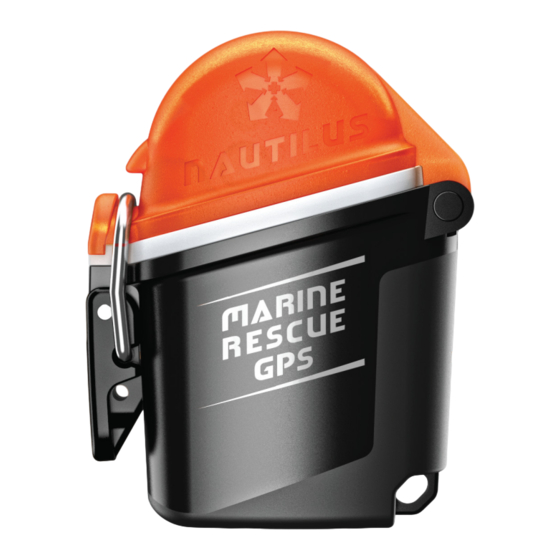Advertisement
Advertisement
Table of Contents

Summary of Contents for Nautilus Marine Rescue GPS
-
Page 2: Table Of Contents
Table of Contents Quick start guide Important! Get to know Nautilus GPS Operation MMSI Test sequence Maintenance Battery Information Rewinding Antenna Specifications... -
Page 3: Quick Start Guide
Hold the red button for 5 seconds to begin distress transmission. * Be cautious when removing antenna retainer. The antenna may spring out rapidly. The Nautilus Marine Rescue GPS is an aid to your safety. It is not a life-saving device. It is not intended to save your life. -
Page 4: Important
IMPORTANT! The Nautilus Marine Rescue GPS is an aid to your safety. It is not a life-saving device. It is not intended to save your life. Performing a test will reduce the This equipment is intended for battery life. Only perform a test emergency use. -
Page 5: Get To Know Nautilus Gps
GET TO KNOW NAUTILUS GPS Antenna Antenna Retainer O-ring Power Button (On/Off) - Blue Dive Cap Dive Cap Clasp Help Button - Red Test Button - Yellow Latch Nautius Marine Rescue GPS Online Manual Nautilus Proprietary Tool www.NautilusLifeLine.com Marine Rescue GPS... -
Page 6: Operation
OPERATION Open the dive cap by releasing the latch. Press the blue button: Nautilus GPS goes to ON standby state and GPS attempts to lock. Pressing the blue button again powers off the LifeLine GPS. • Blue LED flashes slowly while GPS searching •... -
Page 7: Mmsi
If your vessel (or the vessel you are traveling with) has a DSC enabled VHF radio, it is recommended to program the vessel MMSI number into your Nautilus GPS. This allows your Nautilus GPS to send a DSC position report directly to the vessel VHF radio by holding down the yellow button for 5 seconds. -
Page 8: Test Sequence
Note: Test should be done at a temperature between 10-30 degrees Celsius. Press and hold Nautilus GPS Test Button for 5s till ORANGE indicator on Solid Releasing TEST button the ORANGE indicator will flash with the same rate as BLUE indicator •... -
Page 9: Battery Information
REWINDING ANTENNA To rewind the antenna, after use of the Nautilus GPS, use the tool provided in the box. Pass the end of the antenna through the slot of the rewinding tool. Insert the tool into the open space of the top cap. -
Page 10: Specifications
SPECIFICATIONS AIS Transmit Power: 1 Watt AIS Frequency: 161.975 and 162.025 MHz DSC Transmit Power: 0.5 Watt DSC Frequency: 156.525 MHz Messages: Individual Distress Relay, Distress Alert Environmental Temperature Range: -20°C ~ +55°C Waterproof Depth: 425 feet (130 meter) sea water with dive cap closed Splashproof with dive cap open Dimensions: 2.9 x 3.8 x 1.5 inch (75 x 97 x 39mm) Weight: 4.6 oz (131g) after inserting two batteries...



Need help?
Do you have a question about the Marine Rescue GPS and is the answer not in the manual?
Questions and answers